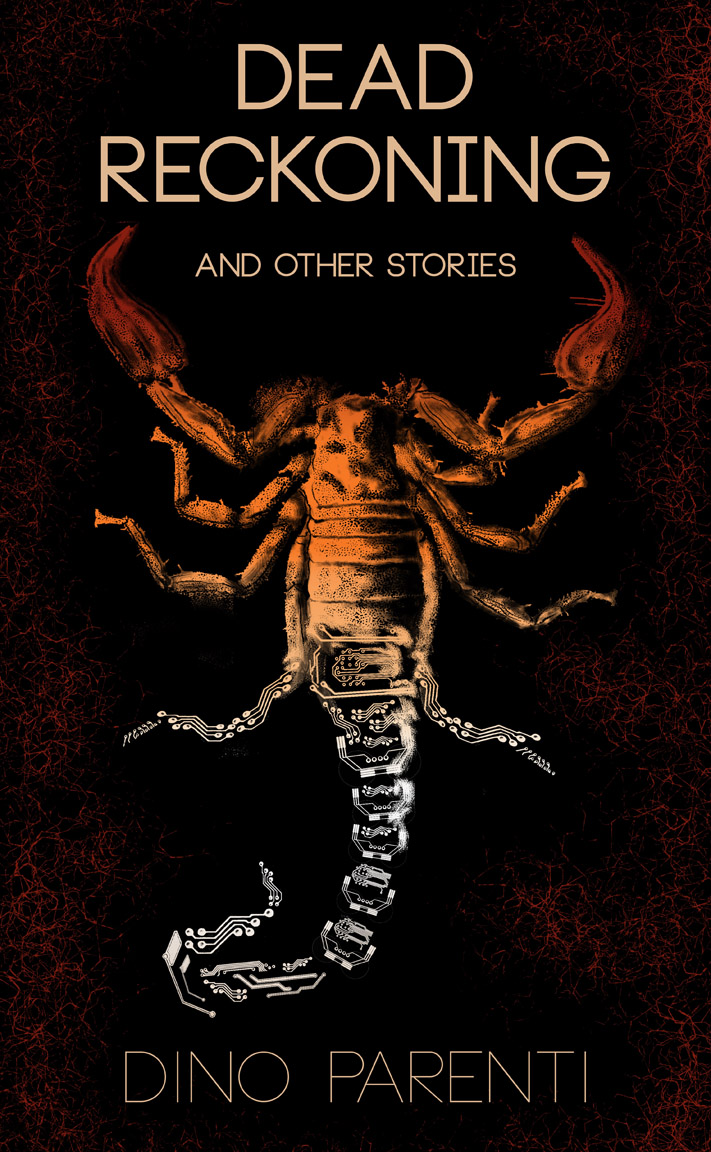This week on The Scariest Part, my guest is Dino Parenti, whose debut collection is Dead Reckoning and Other Stories. Here is the publisher’s description:
An emotional sampler of life on Earth as it once was.
In this collection of sixteen dark, literary tales, disparate characters and their descendants twine and interconnect throughout America from the rural seventies to the post-apocalyptic, stitching together a nefarious mosaic of experiences.
Whether delving into the exploits of a murderous police officer and a lapsing priest engaged in a battle of wills in the sun-blasted dunes of Death Valley, or an anthropologist couple sorting their infertility issues after inadvertently unleashing an Ice Age killer plague, or a mysterious ferry in the Pacific Northwest holding the darkest secrets of a private eye’s final case, or a man so obsessed with touching the infinite that he eagerly volunteers for a one-way mission to preserve the final remnants of mankind, Dead Reckoning and Other Stories ultimately yields a kind of found almanac for human posterity.
And now, let’s hear what the scariest part was for Dino Parenti:
Many years ago I saw a news report about a rapid onset infection that mercilessly ate away at a man in Australia. It started as something seemingly benign — a minor nick from a farming implement as he dug a sluice canal from a stream to his crop patch. Within 72 hours, doctors had amputated both his legs in increments, and had started on his arms before he finally succumbed to full-body sepsis.
Years later, I read another similar account, this one in Canada about a woman, scratched by a squirrel she was hand feeding, who was likewise engaged in a race as to what would reduce flesh and bone from her body faster: infection, or the surgeon’s knife. This time I took note of the condition: necrotizing fasciitis.
It’s more common name is the flesh-eating bacteria, but that’s a bit of a misnomer. It doesn’t eat so much as quickly kills the soft tissue. And like a severe burn, the affected area needs to be either quickly treated or pared away before it starts to infect surrounding tissue, which it does at an alarming rate.
After the initial wave of horror and sympathy for these people overcame me, the writer within reared its head and began ticking off scenarios. How can this ghastly condition work itself into a story? Can this condition provide the ticking-time-bomb element in a narrative?
I’m not proud of my muse’s suspect timing, but all you writers out there know well of its fickle and often cold interventions.
The research of necrotizing fasciitis was, in a word (or two), bloody awful. The images of putrefying flesh and flaying skin have not left my mind, even four years since having written it. It was one of the most trying writing experiences of my life. I couldn’t help but imagine how I’d react to seeing these horrific things happening to my own body. But as shocking as it must be to watch pieces of you discolor, leak, shrivel, and blacken — only to then have a surgeon slice said piece from your body — I got to wondering about the psychological toll that must take on the victim. It happens so fast, is there even time to put it all in perspective in the way perhaps a longer-acting affliction like cancer might offer? To craft a coping mechanism to keep you from losing your mind over such a quick turnaround?
That became the challenge and thrust of my story, “Tooth,” contained in my collection, Dead Reckoning and Other Stories.
A college student named Clara, prideful of her looks and audacity, and freshly ensconced in a new relationship, is suddenly faced with having pieces of her quickly lopped from her head-to-toe. In the crafting of the story, it was soon made manifest that no intricate plot threads were required, no ticking-time-bombs or last minute recoveries as artifice. Rather, Clara’s challenge of dealing with her rapidly looming death became the thrust. The horror of resolving all your life’s fears and existential trials within a span of hours instead of decades, this as you’re being physically reduced in volume each day you still manage to remain alive. It became an obsession in a way, allowing myself to steep in the idea that this microscopic thing inside of you that few antibiotics in the world can tame is killing you through a kind of insidious, inside-out digestion. The thought suddenly reduced more grander external horrors — torture, burning alive, wild animal attack, plane crash, home invasion — to child’s play in comparison. Your own body failing you as the ultimate horror.
I now diligently wash out every little nick and cut before smothering it under a thick bead of Neosporin.
Dead Reckoning and Other Stories: Amazon / Barnes & Noble / Powell’s / IndieBound
Dino Parenti: Website / Facebook / Twitter / Goodreads
Dino Parenti is a writer of dark literary and speculative fiction. He is the winner of the first annual Lascaux Reviewflash fiction contest and is featured in the Anthony Award-winning anthology Blood on the Bayou. His work can be found in Pantheon Magazine, Menacing Hedge, Pithead Chapel, as well as other anthologies. He is a fiction editor at Gamut Magazineand a member of the HWA. His short-fiction collection, Dead Reckoning and Other Stories, was just released with Crystal Lake Publishing. When not purging his soul into a laptop thanks to a far-too-early exposure to Stephen King, Scorsese movies, and Camus, he can be found photographing the odd junk pile, building furniture, or earning a few bucks as a CAD drafter. He lives in Los Angeles.



Leave a Reply